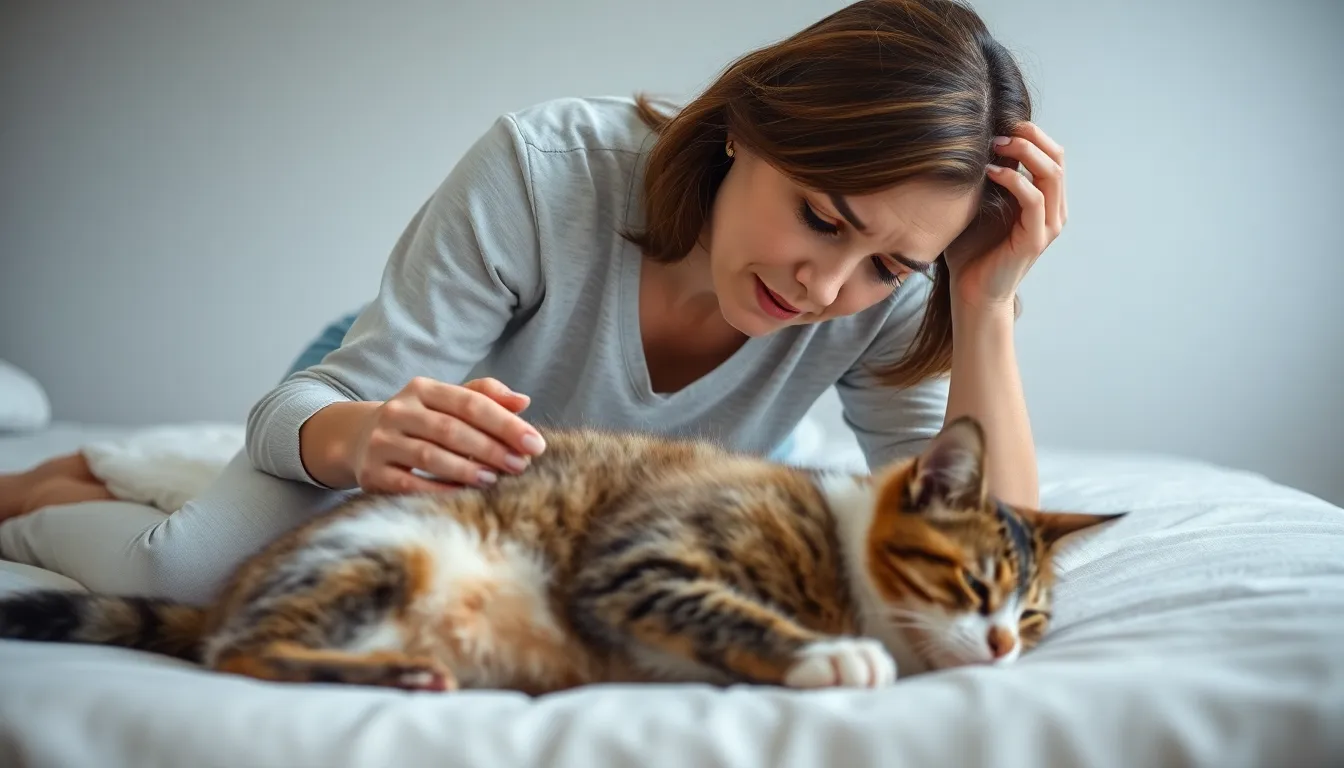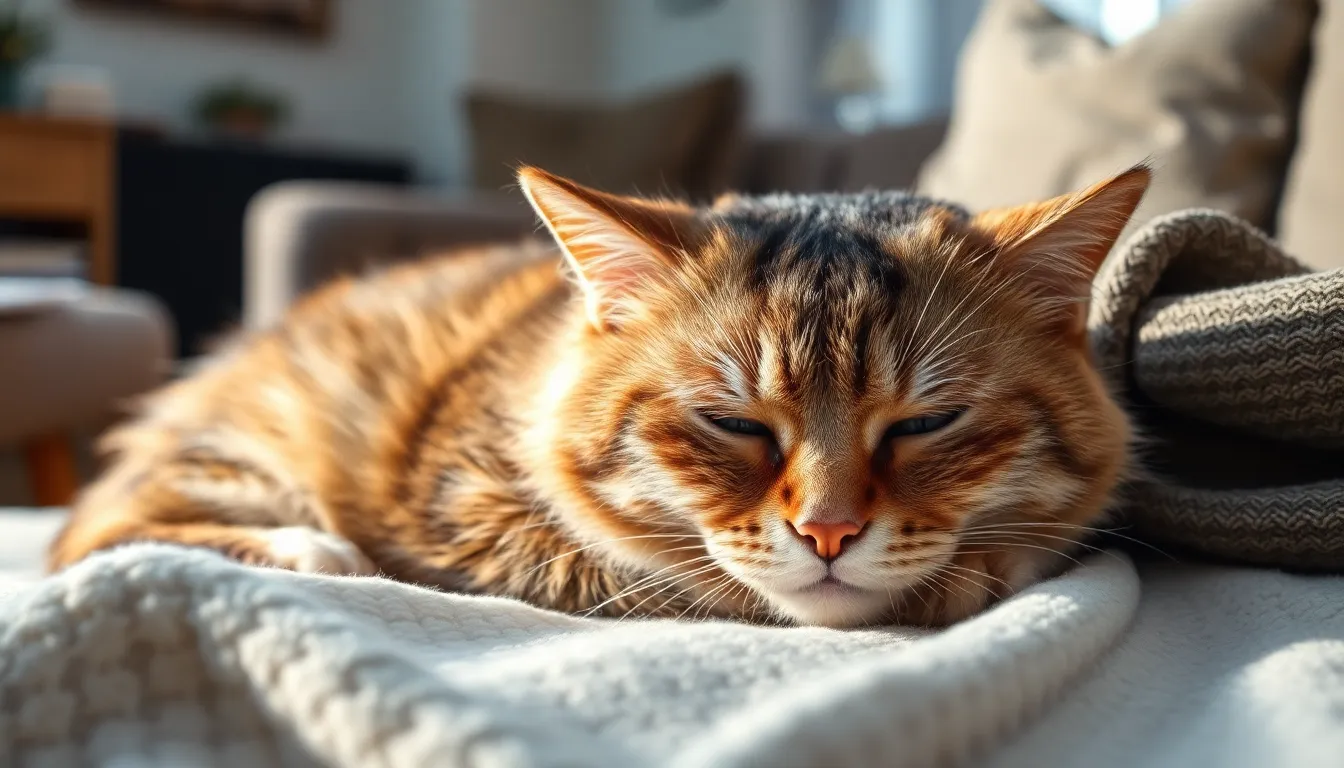Table of Contents
ToggleCats are mysterious creatures, often keeping their humans guessing about their health and well-being. One moment they’re chasing imaginary mice, and the next, they seem to be plotting their grand exit from this world. If you’ve noticed some unusual behavior in your feline friend, it’s time to tune in and decode the signs.
Understanding the signs that a cat may be nearing the end of its life isn’t just for the faint-hearted; it’s crucial for giving them the care they deserve. From sudden changes in appetite to that infamous “I’m too tired to care” attitude, these signals can be subtle yet significant. So grab a cup of catnip tea and let’s dive into the telltale signs that your furry companion might be saying goodbye.
Understanding the Signs My Cat Is Dying
Observing a cat’s health is essential for any pet owner. Significant changes in behavior often indicate underlying issues. Common signs include decreased appetite. A cat that once eagerly approached food might suddenly show disinterest.
Weight loss can occur alongside reduced food intake. Noticeable thinning of a cat’s body may signal serious health concerns. Increased lethargy also warrants attention. If a typically active cat spends most of the day sleeping and avoids play, something might be wrong.
Changes in grooming habits reveal another aspect of feline health. Cats that once maintained a clean coat could stop grooming themselves, leading to matted fur. Altered restroom habits can provide further indication of distress. Difficulty using the litter box or changes in stool consistency may suggest illness.
Vocalization changes might occur too. Increased meowing or unusual sounds can indicate pain or discomfort. Similarly, hiding more than usual signifies that a cat may not feel well. Isolation from family members often highlights underlying medical issues.
Lastly, difficulties in movement must not be overlooked. An inability to jump or walk normally can suggest severe problems. Awareness of these signs ensures timely intervention, allowing for proper care when necessary. Regular veterinary check-ups also support a cat’s health, helping to catch issues early on.
Common Signs of Deteriorating Health

Pet owners must recognize signs of a cat’s declining health. Observing physical changes and behavioral shifts can provide crucial insights into their well-being.
Physical Signs to Watch For
Decreased appetite often leads to noticeable weight loss. Noticeable fluctuations in weight indicate potential health issues. Increased lethargy suggests a loss of energy and interest in activities. Changes in grooming habits, such as excessive or diminished grooming, can signal distress or discomfort. Additionally, altered restroom behaviors, like increased frequency or accidents outside the litter box, warrant attention. Any difficulty in movement, such as limping or reluctance to jump, signals pain. These symptoms may indicate serious underlying health problems, necessitating prompt veterinary consultation.
Behavioral Changes in Your Cat
Vocalization changes can indicate discomfort or distress, often manifesting as increased yowling or meowing. Altered sleeping patterns, such as excessive sleep or restlessness, often reflect anxiety or illness. Withdrawal from social interactions signals a decrease in overall comfort or health. Cats may exhibit unusual hiding behavior, seeking solitude more than typical. Additionally, decreased interest in play or normal activities raises concern. Changes in behavior can frequently precede more serious health issues, and vigilance is essential for timely intervention.
Specific Symptoms to Notice
Recognizing specific symptoms is crucial for assessing a cat’s health. Being observant can lead to timely care and intervention.
Changes in Eating and Drinking Habits
Weight loss often results from reduced food intake. Lack of interest in food or water can indicate serious health concerns. Noticeable changes in eating patterns may include sudden refusal of favorites. A cat may also drink less, leading to dehydration. Monitoring water bowls can reveal decreased fluid intake. These behaviors can signal illness, so pet owners should act promptly.
Changes in Grooming and Hygiene
Grooming habits frequently reflect a cat’s well-being. Cats may stop grooming altogether when they feel unwell. Excessive grooming can also occur as they try to cope with discomfort. Look for unkempt fur, mats, or a change in coat quality. Signs like bad odors or litter box issues may worsen, indicating problems. Any drastic behavior shifts deserve attention and potentially a vet visit.
Emotional Impact on Pet Owners
Caring for a cat nearing the end of its life deeply affects pet owners emotionally. Grief may surface as they observe subtle signs indicating their cat’s decline. Anxiety arises when noticing decreased appetite or increased lethargy. Fear often accompanies the uncertainty of their pet’s health status, leading to restless nights spent worrying.
Frustration can result from the difficulty in understanding their cat’s needs as behaviors change. Invitations to reassurance become vital during this challenging time. Comforting conversations with friends and family may help alleviate some emotional struggles. Seeking the support of a veterinarian provides peace of mind and clarity about potential health conditions.
Appreciating the bond shared with a beloved cat enhances the emotional experience. Cherished memories often resurface as owners reflect on joyful moments. Observing signs of impending loss can trigger feelings of helplessness. Acceptance of the situation often proves difficult, as owners wish for more time together.
Advocating for their cat’s well-being becomes a priority, prompting discussions about palliative care or hospice options. Owners might choose to create a comfortable environment that respects their pet’s final days. Having conversations about end-of-life decisions can be incredibly challenging but necessary. Each decision reflects the love and commitment they feel toward their feline companions.
Acknowledging these emotions proves essential for the owner’s well-being. Engaging in open dialogue with others who understand the experience fosters community support. Ultimately, navigating the emotional impact of a pet’s decline requires courage, compassion, and a focus on the cherished moments shared together.
Recognizing the signs that a cat may be nearing the end of its life is crucial for any pet owner. By staying alert to changes in behavior and physical health, owners can ensure their feline companions receive the care they need during this difficult time. It’s important to approach these signs with empathy and understanding while prioritizing the cat’s comfort and well-being.
Cherishing the bond shared with a beloved pet can provide solace amid the emotional challenges of this journey. Seeking support from friends, family, or veterinarians can help navigate the complexities of caring for a declining cat. Ultimately, being proactive and compassionate can make a significant difference in both the cat’s quality of life and the owner’s experience.





